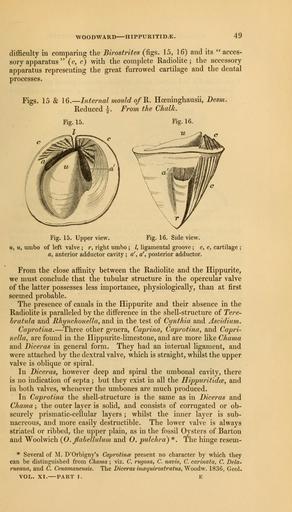MAKE A MEME
View Large Image

| View Original: | The_Quarterly_journal_of_the_Geological_Society_of_London_(12711339145).jpg (1828x3200) | |||
| Download: | Original | Medium | Small | Thumb |
| Courtesy of: | commons.wikimedia.org | More Like This | ||
| Keywords: The Quarterly journal of the Geological Society of London (12711339145).jpg WOODWARD HIPPURITID <br> 49 <br> difficulty in comparing the Birostrites figs 15 16 and its acces- <br> sory apparatus c c with the complete Radiolite ; the accessory <br> apparatus representing the great furrowed cartilage and the dental <br> processes <br> Figs 15 16 ” Internal mould of Hceninghausii Desm <br> From the Chalk <br> Reduced \ <br> Fig 15 <br> Fig 16 <br> Fig 15 Upper view Fig 16 Side view <br> M u umbo of left valve ; r right umbo ; / ligamental groove ; c c cartilage ; <br> a anterior adductor cavity ; a' a\ posterior adductor <br> From the close affinity between the Radiolite and the Hippurite <br> we must conclude that the tubular structure in the opercular valve <br> of the latter possesses less importance physiologically than at first <br> seemed probable <br> The presence of canals in the Hippurite and their absence in the <br> Radiolite is paralleled by the difference in the shell-structure of Te7'e- <br> bratula and Rhynchonella and in the test of Cynthia and Ascidium <br> Caprotina ” Three other genera Caprina Caprotina and Capri- <br> nella are found in the Hippurite-limestone and are more like Chama <br> and Diceras in general form They had an internal ligament and <br> were attached by the dextral valve which is straight whilst the upper <br> valve is oblique or spiral <br> In Diceras however deep and spiral the umbonal cavity there <br> is no indication of septa ; but they exist in all the Hippuritidce and <br> in both valves whenever the umbones are much produced <br> In Caprotina the shell-structure is the same as in Diceras and <br> Chama ; the outer layer is solid and consists of corrugated or ob- <br> scurely prismatic-cellular layers ; whilst the inner layer is sub- <br> nacreous and more easily destructible The lower valve is always <br> striated or ribbed the upper plain as in the fossil Oysters of Barton <br> and Woolwich O Jlabellulum and O pulchra The hinge resem- <br> Several of M D'Orbigny's Caprotinoe present no character by which they <br> can be distinguished from Chama ; viz C rugosa C navis C carinata C Dela- <br> rueana and C Cenomanensis The Diceras inaquirostratus Woodw 1836 Geol <br> VOL XI PART I E 35614609 110213 51125 Page 49 Text v 11 http //www biodiversitylibrary org/page/35614609 1855 Geological Society of London NameFound Ascidium NameConfirmed Ascidium EOLID 6543852 NameBankID 241170 NameFound Birostrites NameConfirmed Birostrites NameBankID 4091011 NameFound Caprina NameConfirmed Caprina NameBankID 112500 NameFound Caprotina NameConfirmed Caprotina NameBankID 4103255 NameFound Chama NameConfirmed Chama EOLID 10720381 NameBankID 2693785 NameFound Chama carinata NameConfirmed Chama circinata Monterosato 1878 EOLID 2978198 NameBankID 7206909 NameFound Chama navis NameConfirmed Chama EOLID 10720381 NameBankID 2693785 NameFound Chama rugosa NameFound Diceras NameConfirmed Diceras EOLID 13271618 NameBankID 2636432 NameFound Orthoceras pulchra NameConfirmed Orthoceras pulchrum NameBankID 5681402 NameFound Rhynchonella NameConfirmed Rhynchonella EOLID 4328553 NameBankID 4331849 Biodiversity Heritage Library The Quarterly journal of the Geological Society of London v 11 1855 Geology Periodicals Smithsonian Libraries bhl page 35614609 dc identifier http //biodiversitylibrary org/page/35614609 smithsonian libraries Information field Flickr posted date ISOdate 2014-02-23 Check categories 2015 August 26 CC-BY-2 0 BioDivLibrary https //flickr com/photos/61021753 N02/12711339145 2015-08-26 20 59 56 cc-by-2 0 PD-old-70-1923 The Quarterly journal of the Geological Society of London 1855 Photos uploaded from Flickr by Fæ using a script | ||||